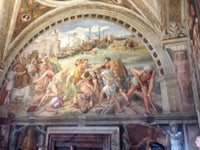See all Museums in Rome
Vatican Museums (Musei Vaticani) & the Sistine Chapel (Cappella Sistina)
Viale Vaticano, 2, Città del Vaticano, Vatican City Phone: 39 06 6988 4676About
The Vatican Museums boast one of the world's greatest art collections. They're a gigantic repository of treasures from antiquity and the Renaissance, all housed in a labyrinthine series of lavishly adorned palaces, apartments, and galleries leading you to the real gem: the Sistine Chapel. The Vatican Museums occupy a part of the papal palaces built from the 1200s onward. From the former papal private apartments, the museums were created over a period of time to display the vast treasure trove of art acquired by the Vatican. To reach the ticket windows, you take an escalator, although you exit down a magnificent spiral ramp. Signs will direct you on your way to the highlights. Obviously, 1, 2, or even 20 trips will not be enough to see the wealth of the Vatican, much less to digest it. With that in mind, we've previewed only a representative sampling of the masterpieces on display (in alphabetical order). Borgia Apartments: Frescoed with biblical scenes by Pinturicchio of Umbria and his assistants, these rooms were designed for Pope Alexander VI (the infamous Borgia pope). They might be badly lit, but they boast great splendor and style. At the end of the Raphael Rooms is the Chapel of Nicholas V, an intimate room frescoed by the Dominican monk Fra Angelico, the most saintly of all Italian painters. Chiaramonti Museum: Founded by Pope Pius VII, also known as Chiaramonti, the museum includes the Corridoio (Corridor), the Galleria Lapidaria, and the Braccio Nuovo (New Side). The Corridor holds more than 800 Greek and Roman works, including statues, reliefs, and sarcophagi. In the Galleria Lapidaria are about 5,000 Christian and pagan inscriptions. In the Braccio Nuovo, built as an extension of the Chiaramonti, you can admire The Nile, a magnificent reproduction of a long-lost Hellenistic original and one of the most remarkable pieces of sculpture from antiquity. The imposing statue of Augustus of Prima Porta presents him as a regal commander. Collection of Modern Religious Art: This museum, opened in 1973, represents American artists' first invasion of the Vatican. Of the 55 rooms, at least 12 are devoted to American artists. All the works chosen were judged on their "spiritual and religious values." Among the American works is Leonard Baskin's 1.5m (5-ft.) bronze sculpture of Isaac. Modern Italian artists such as De Chirico and Manzù are also displayed, and there's a room of paintings by the Frenchman Georges Rouault. You'll also see works by Picasso, Gauguin, Gottuso, Chagall, Henry Moore, Kandinsky, and others. Egyptian Gregorian Museum: Experience the grandeur of the pharaohs by studying sarcophagi, mummies, and statues of goddesses, vases, jewelry, sculptured pink-granite statues, and hieroglyphics. Etruscan Gregorian Museum: This was founded by Gregory XIV in 1837 and then enriched year after year, becoming one of the most important and complete collections of Etruscan art. With sarcophagi, a chariot, bronzes, urns, jewelry, and terra-cotta vases, this gallery affords remarkable insights into an ancient civilization. One of the most acclaimed exhibits is the Regolini-Galassi tomb, unearthed in the 19th century at Cerveteri. It shares top honors with the Mars of Todi, a bronze sculpture probably dating from the 5th century B.C. Ethnological Museum: This is an assemblage of works of art and objects of cultural significance from all over the world. The principal route is a .5km (1/3-mile) walk through 25 geographical sections, displaying thousands of objects covering 3,000 years of world history. The section devoted to China is especially interesting. Historical Museum: This museum tells the history of the Vatican. It exhibits arms, uniforms, and armor, some dating from the early Renaissance. The carriages displayed are those used by the popes and cardinals in religious processions. Pinacoteca (Picture Gallery): The Pinacoteca houses paintings and tapestries from the 11th to the 19th centuries. In room no. 1, note the oldest p

